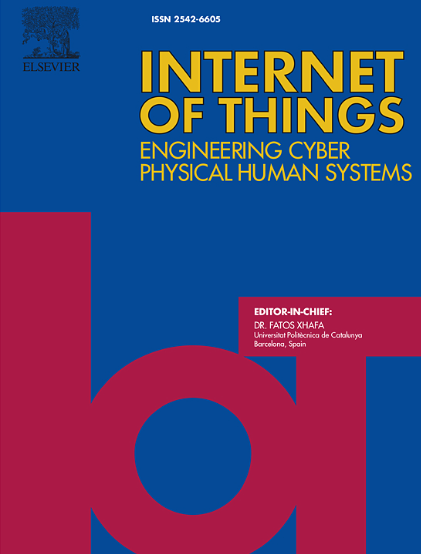An energy-focused model for batteryless IoT: Vortex wireless power transfer and fog computing in 6 G networks
IF 6
3区 计算机科学
Q1 COMPUTER SCIENCE, INFORMATION SYSTEMS
引用次数: 0
Abstract
The Internet of Things (IoT) refers to the networked interconnection of devices that collect, exchange, and analyze data to enable intelligent applications. In emerging sixth-generation (6 G) networks, batteryless IoT devices have gained significant attention, as they rely on ambient energy harvesting rather than traditional batteries. This paper presents an energy-focused model for a 6G-enabled batteryless IoT network that integrates Vortex Wireless Power Transfer (WPT) with fog node coordination to manage energy harvesting and computation offloading. WPT exploits electromagnetic resonance to deliver energy wirelessly. Our vortex‐based model applies exponential attenuation, enhancing energy harvesting for batteryless IoT devices. Then system dynamically assigns IoT devices to optimal WPT zones based on coverage and received power, while simultaneously determining whether tasks should be executed locally or offloaded to Mobile Edge Computing (MEC)-enabled fog nodes, based on real-time energy and latency constraints. To solve the result of the NP-hard optimization problem, we develop an Enhanced Adaptive Quantum Binary Particle Swarm Optimization (EAQBPSO) algorithm that effectively balances workload distribution, energy harvesting, and consumption. Simulation results indicate that our approach significantly outperform traditional methods, achieving improvements of up to 71 % in energy efficiency, nearly 87 % in energy harvesting efficiency, and reducing average energy consumption per task by over 40 %.
无电池物联网的能量聚焦模型:6g网络中的涡旋无线电力传输和雾计算
物联网(Internet of Things, IoT)是指设备之间的网络互联,通过收集、交换和分析数据来实现智能应用。在新兴的第六代(6g)网络中,无电池物联网设备受到了极大的关注,因为它们依赖于环境能量收集而不是传统的电池。本文提出了一种以能量为中心的模型,用于支持6g的无电池物联网网络,该网络将涡流无线电力传输(WPT)与雾节点协调集成在一起,以管理能量收集和计算卸载。WPT利用电磁共振无线传输能量。我们基于涡流的模型应用指数衰减,增强了无电池物联网设备的能量收集。然后,系统根据覆盖范围和接收功率动态地将物联网设备分配到最佳WPT区域,同时根据实时能量和延迟限制,确定任务是应该在本地执行还是卸载到支持移动边缘计算(MEC)的雾节点。为了解决NP-hard优化问题的结果,我们开发了一种增强自适应量子二进制粒子群优化(EAQBPSO)算法,该算法有效地平衡了工作负载分配、能量收集和消耗。仿真结果表明,我们的方法明显优于传统方法,在能源效率方面提高了71%,在能量收集效率方面提高了近87%,并将每个任务的平均能耗降低了40%以上。
本文章由计算机程序翻译,如有差异,请以英文原文为准。
求助全文
约1分钟内获得全文
求助全文
来源期刊

Internet of Things
Multiple-
CiteScore
3.60
自引率
5.10%
发文量
115
审稿时长
37 days
期刊介绍:
Internet of Things; Engineering Cyber Physical Human Systems is a comprehensive journal encouraging cross collaboration between researchers, engineers and practitioners in the field of IoT & Cyber Physical Human Systems. The journal offers a unique platform to exchange scientific information on the entire breadth of technology, science, and societal applications of the IoT.
The journal will place a high priority on timely publication, and provide a home for high quality.
Furthermore, IOT is interested in publishing topical Special Issues on any aspect of IOT.
 求助内容:
求助内容: 应助结果提醒方式:
应助结果提醒方式:


